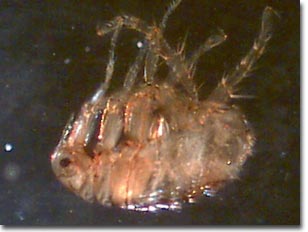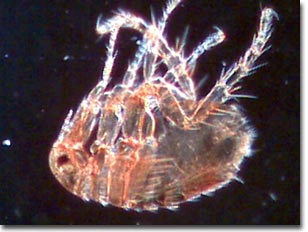Advanced Condenser Systems: Abbe Condensers
Flea Whole Mount
The images below compare performance of the Intel Play QX3 Computer Microscope with and without the aid of an organized cone of illumination from a darkfield Abbe substage condenser containing an aperture diaphragm. These photomicrographs are unretouched and were captured with the QX3 interactive software.
Fleas thrive in a warm and humid environment and, while wingless, they can jump as high as two feet. Approximately one percent of an entire flea population exists in the adult stage, making it critical to treat the entire environment when dealing with an infestation. Adult fleas are triggered to jump by a passing shadow and they can live for several months without food. Once attached to a host (dog, cat, human, etc.) they become permanent residents, although they only survive for three to four days after a blood meal. A female adult flea can lay only approximately 20 eggs per setting, but she is capable of producing up to 500 eggs in a lifetime.
Flea Whole Mount


Semi-transparent insects and mites are difficult to image using unaided brightfield optical microscopy. The images above were recorded using the Intel Play QX3 microscope in transmitted darkfield illumination mode. On the top is a digital image from a stock QX3 microscope using auxiliary illumination provided by a fiber optic light pipe through a hole drilled into the mixing chamber. The image on the bottom was recorded using the QX3 microscope body and a Nikon achromatic substage condenser of low numerical aperture.
BACK TO TRANSMITTED DARKFIELD GALLERY
